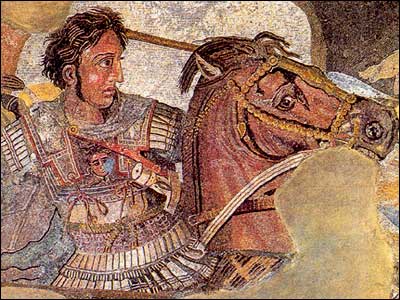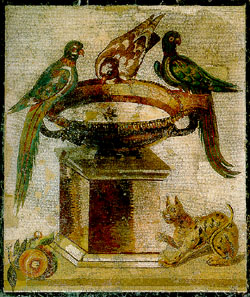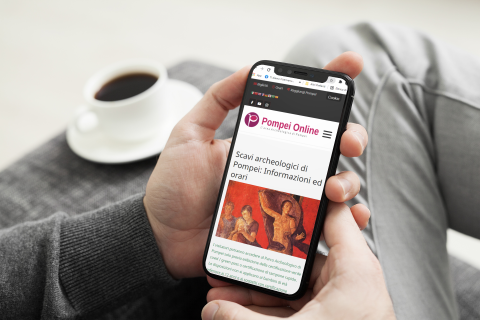 Mosaic ornamentation was widely used in the decoration of the houses in Pompeii and saw various stages of development. The oldest examples are works executed with simple motifs, using tesserae of rough workmanship and of modest material; those of subsequent epochs, on the other hand, show refinement in their composition, in their taste in colour and in the preciousness of the tesserae used. In the first period the works are characterized by the repetition of simple geometric motifs or they repeat the pictorial patterns of the second, third and fourth phases. Mosaics were often used as flooring. There are some admirable examples: the famous "cave canem" placed at the entrance to many houses is perhaps the best-known among the many which have survived. The panel depicting "The Battle of Alexander" housed in the Archaeological Museum in Naples and originating from the House of the Faun, is, though, one of the most important and magnificent examples.
Mosaic ornamentation was widely used in the decoration of the houses in Pompeii and saw various stages of development. The oldest examples are works executed with simple motifs, using tesserae of rough workmanship and of modest material; those of subsequent epochs, on the other hand, show refinement in their composition, in their taste in colour and in the preciousness of the tesserae used. In the first period the works are characterized by the repetition of simple geometric motifs or they repeat the pictorial patterns of the second, third and fourth phases. Mosaics were often used as flooring. There are some admirable examples: the famous "cave canem" placed at the entrance to many houses is perhaps the best-known among the many which have survived. The panel depicting "The Battle of Alexander" housed in the Archaeological Museum in Naples and originating from the House of the Faun, is, though, one of the most important and magnificent examples.
 This emblem, found in 1855 in S. Maria Capua Vetere (the modern name for ancient Capua), is a variation of the renowned Sosos mosaic from Pergamum of which we are reminded by Pliny (Nat.Hist.XXXVI, 184) on account of the admirable rendering given to the reflection in the waters of the basin of a dove that is perched on the edge waiting to drink. Mosaic copies of the original from Pergamum, granted that the one found in Villa Adriana might actually be the Sosos work itself, have been found at Delos, Pompeii (VIII 2, 34; this is the liveliest both for the number of doves that have been depicted and for the fact that one of them is still flying), Ostia and Rabat, not to mention the more than thirty-six garden-painting variations that have been enumerated so far.
This emblem, found in 1855 in S. Maria Capua Vetere (the modern name for ancient Capua), is a variation of the renowned Sosos mosaic from Pergamum of which we are reminded by Pliny (Nat.Hist.XXXVI, 184) on account of the admirable rendering given to the reflection in the waters of the basin of a dove that is perched on the edge waiting to drink. Mosaic copies of the original from Pergamum, granted that the one found in Villa Adriana might actually be the Sosos work itself, have been found at Delos, Pompeii (VIII 2, 34; this is the liveliest both for the number of doves that have been depicted and for the fact that one of them is still flying), Ostia and Rabat, not to mention the more than thirty-six garden-painting variations that have been enumerated so far.
The basin is low-footed, hemispherical and in gilded bronze. In other less faithful versions, the legs are higher and may be lion-pawed or sheep-toed. Perched on the edge are two parrots of slightly different plumage and a columba livia with its head bowed towards the water upon which there floats a small leaf. The recipient is supported by a high cubic base near which we can see a pomegranate and a feline beast, all details added on by the Campanian mosaic-worker.
The insertion into the original plan of what was for the Greeks (and even more so for the Romans) such an exotic species of birds as the parrot, is especially interesting. It acts as a sort of point of indirect contact with the Eastern world, which had been established in a more long-lasting fashion by Alexander the Great's Indian campaign. The lack of precision in the painting of the plumage, in which we can see characteristics of different species all mixed up, seems to confirm lack of direct knowledge of these birds, and the absence of any pictorial model upon which the copy-artist might have based his work.
Another interesting element which helps us understand the manner in which Roman age copy-artists worked is the cat. It is not only quite out of proportion with respect to the birds and the pomegranate, but its shadow lies towards the right, as if the scene was illuminated by light from the left side, despite the fact the this detail is not supported in other areas of the composition; this is another clear sign that the picture has been put together, almost mechanically, from as number of different cartoon features.



